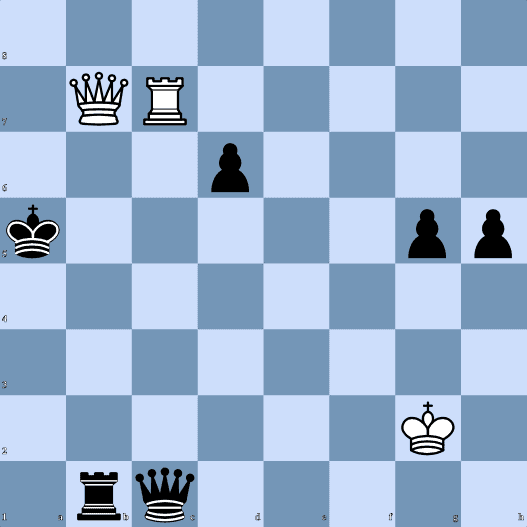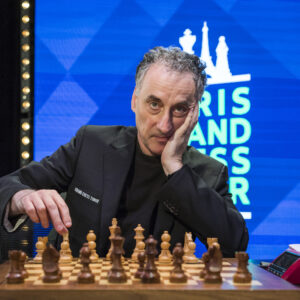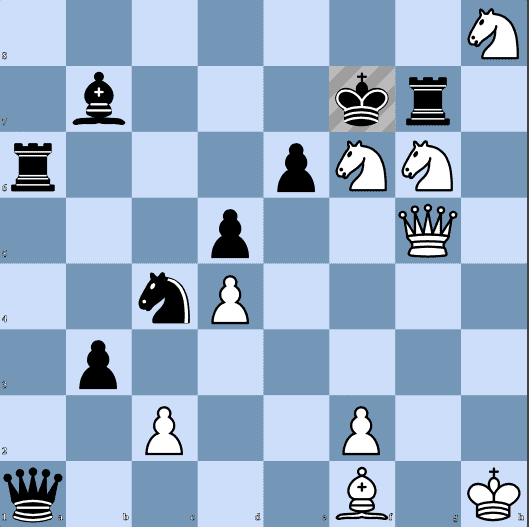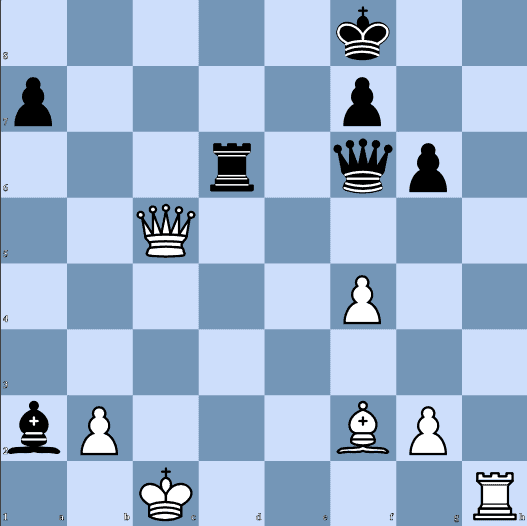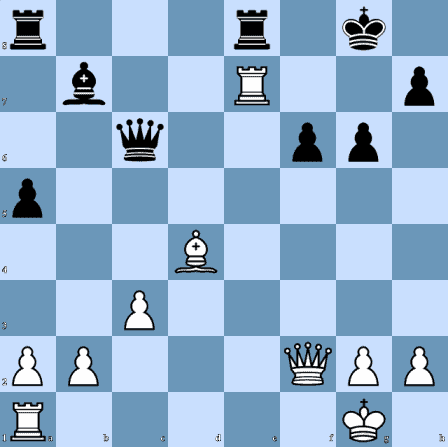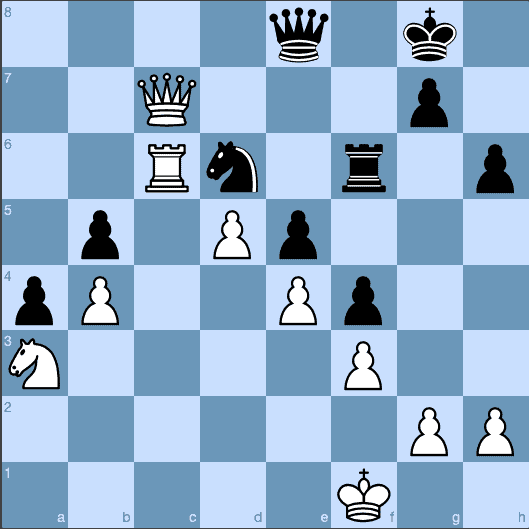We start the week with a new selection of Malcolm Pein’s Daily Telegraph columns, covering a wide range of subjects, complete with numerous opportunities to test your own chess strength.
Endgame Prowess
MOHAMMAD Tabatabaei of Iran had a fine run at the FIDE World Cup, winning five matches that included two successes against 2700+ players Yu Yangyi and Pentyla Harikrishna. Deft endgame play that we’ll see below gave Tabatabaei the lead in the match against Harikrishna.
In the return with black, he held another endgame, but one in which his opponent was pressing, in 115 moves. Tabatabaei’s run was only halted in the quarter-finals when he overlooked Vladimir Fedoseev’s final trick, which was presented as a puzzle last time.
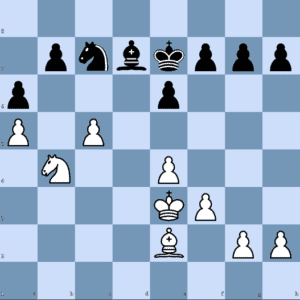
M. Tabatabaei – P. Harikrishna, position after 30.Ke3:
30…Bb5?! Time trouble was already a factor, White plans f2–f4 and h2–h4 and Black can only wait, but 30…Nb5 looks the most solid choice and if 31.e5 Na7 32.f4 Nc6 or 31.f4 Na7 32.Bf3 Nc6 33.Nxc6+ Bxc6 34.Kd4 f6 and sit. Another possible defence 20…e5 31.Nd5+ when black Black can keep calm and carry on with 31…Kd8 and if 32.Bc4 Ne6 picks up c5, and the danger has passed. 31.Bxb5 Nxb5 32.c6! (Trying to create a passed a-pawn, a huge asset in a knight endgame) 32…bxc6 (32…Nd6 33.Kd4 Kd8 34.Kc5 Kc7 35.e5 Nf5 36.cxb7 Kxb7 37.f4 followed by bringing the knight to d6 looks very unpleasant for Black and even; “ I have good winning chances my pawn structure is much better” – MT) 33.e5! (This looks winning already. 33.Nxa6 Kd6 followed by c6–c5 and Kc6 holds 34.Nb4 Nc7 halts the a-pawn as if 35.a6? c5) 33…Nc7 34.Kd4 Kd7 35.Kc5 (White is taking on c6 and avoiding b6 because of Nd5+) 35…f6 36.Nxc6 Nd5 37.exf6 gxf6 38.Nb8+ Kc7 39.Nxa6+ Kb7 (Tabatabaei uses his a-pawn as a diversion and wins on the opposite wing) 40.Nb4 Ne3 41.a6+ Ka7 42.Kd6 e5 43.Ke6 Nxg2 44.Kxf6 Nh4 45.Nc6+! Kxa6 46.Nxe5 Ng2 47.Kg7 Kb6 (47…h5 48.Kg6 h4 49.Kg5 Kb6 50.f4 Kc7 51.Nf3) 48.Kxh7 Kc5 49.Kg6 Kd4 50.Kf6 Ke3 51.Kf5 Kd4 52.f4 Kd5 (52…Ke3 53.Ng6) 53.Ng6 Ne3+ 54.Kg5 Ke6 55.h4 Nc4 56.h5 Nd6 57.Ne5 1–0
The conclusion to one of the best games in the competition. Duda-Vidit, quarter-finals game two.
Test Your Strength
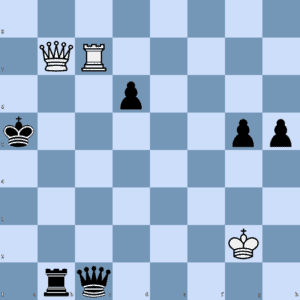
White can win in many ways, but how does he mate in three?
Highlight the space below this line to reveal the answer.
49.Qa7+ Kb5 50.Qb8+ 1-0 Or 49.Qa8+ Kb5 50.Qb8+ Ka5 51.Ra7#.
Duda Defies Carlsen
JAN-KRZYSZTOF Duda, the 23-year-old Polish number one who broke Magnus Carlsen’s 125-game unbeaten streak at the Norway Chess tournament last October, defeated the world champion again in the tie-breaker of their FIDE World Cup semifinal.
Duda advanced to the final against 2016 title challenger Sergey Karjakin. Both players qualified for the 2022 Candidates tournament.
Duda pressed in game one and survived in game two when he found the only move to stay in the game with just two seconds left on the clock. The first Rapid game was a draw.
We pick up the second tie-breaker after 25…a4 26.b4?!, after which White’s queenside pawns are fixed on dark squares and are vulnerable. Instead, after 26.bxa4 or 26.Rb2 Bxa3 27.Ra2! – computer, White should be OK.
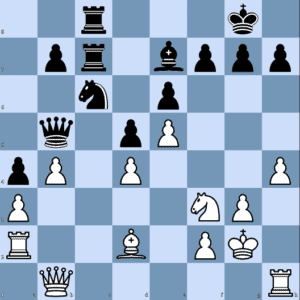
M. Carlsen – J. K. Duda
26…h6! 27.Be3 Na7! 28.Bd2 Qe2 29.Re1 Qc4 (29…Qa6!) 30.Re3 Nb5 31.Rd3 Rc6! 32.Rb2 Bd8! 33.g4 Bb6 34.Be3 Nc3 35.Qf1 Qb5 36.Rc2 Ne4 37.Rxc6 Rxc6 38.Rd1 Rc4 (38…Qxf1+ 39.Rxf1 Nc3 40.Rc1 Nb5 wins a pawn) 39.Nd2 Nxd2 40.Rxd2 Qc6 41.Qe2 Rc3 42.Ra2? (An unfortunate square, 42.g5 was playable and if 42…hxg5 43.hxg5 Qc4 44.Qg4, or 43…Rxa3 44.Rd1! intending Rh1) 42…Bd8 43.g5 hxg5 44.hxg5 Qc4! 45.Qxc4 dxc4
(After 45…Rxc4 d4 or a3 falls) 46.d5 (Desperation, but it nearly pays off ) 46…exd5 47.Rd2
Test Your Strength
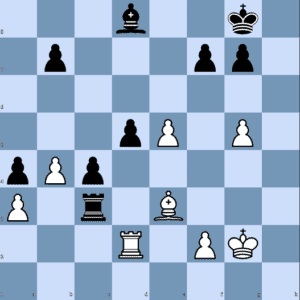
Black to play and win
47…Rd3? 48.Rxd3 cxd3 49.f4 Kf8
(The players were virtually down to increment. 49…f6! wins 50.Kf3 fxe5 51.fxe5 Kf7 52.Kg4 Ke6, or 50.g6 fxe5 51.fxe5 Kf8 52.Kf3 Ke7!) 50.Kf3 Ke7 (Again 50…f6!) 51.Bc5+ Ke6 52.Ke3 Kf5 53.Kxd3 g6 54.Be3 Bc7 55.b5? (Logical, but giving Black more diagonals) 55…Bd8 56.Kd4 Bb6+ 57.Kd3 Bd8 58.Kd4 Be7 59.Bc1 Ke6 60.Bb2 Bd8 61.Kc5 Ba5 62.Bc1? (62.Bd4 Bd8 63.Bb2 Be7+ 64.Kd4! holds and not 64.Kb6 Bxa3! 65.Bxa3 d4 66.Kxb7 d3 67.Bb4 a3. If 62.Bd4 Bd2?? 63.Kb6 wins) 62…Bc3! 63.b6 (The key variation: 63.Kb6 d4 64.Kxb7 d3 65.Kc6 d2 66.Bxd2 Bxd2 67.b6 Bxf4 68.b7 Bxe5) 63…d4 64.Kc4 Kd7! 65.Be3 Bb2 66.Bxd4 Bxa3 67.Be3 Bb2 68.Kb4 a3 69.Kb3 Ke6 70.Ka2 (70.Bc5 Kf5) 70…Kd5 71.Kb3 Ke4 72.Bd2 Bd4 73.Kxa3 Bxb6 74.Kb4 Bf2 0-1 Black takes all three.
Highlight the space below this line to reveal the answer.
47…Rxa3 48.Rxd5 Rd3! wins.
Carlsen’s Masterclass
MAGNUS Carlsen’s response to elimination from the FIDE World Cup was to give a masterclass as he defeated Vladimir Fedoseev 2-0 in the match for third place.
Only $8,000 (£5,700) was at stake. After a month of hard slog, it hardly seems worth it, but Carlsen always wants to play.
V. Fedoseev – M. Carlsen
King’s Indian
1.d4 Nf6 2.c4 g6 3.h4 Bg7 4.Nc3 d6 5.e4 Nc6 (As in the Pirc Defence, countering White’s brazen aggression with play in the centre is best. If 6.Nf3 Bg4; 6.Be3 e5 or 6…Ng4) 6.d5 Ne5 7.Be2 h5 8.Bf4 0–0 9.Nf3 Nxf3+ 10.gxf3 (White’s king can never be secure after this. 10.Bxf3 Bg4 or 10…c6 are both fine) 10…c6 11.Qd2 cxd5 12.cxd5 Kh7 13.a4 Nd7 14.a5 f5 15.Ra3 Ne5 16.Be3 f4 17.Bxf4 Bd7 18.Nd1
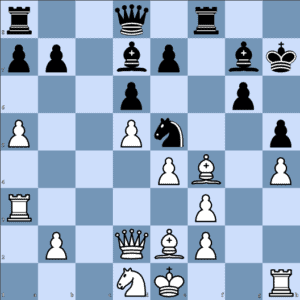
18…Rxf4!! 19.Qxf4 Bh6 20.Qg3 Qf8 21.Ne3 Bf4 22.Qg2 Rc8 23.Rc3?! (White’s pieces become entombed in a 4×4 square, as Ian Nepomniachtchi pointed out on Twitter. 23.0–0 Qf6 and 23.Kd2 Nc4+ were better but both look difficult for White) 23…Rxc3 24.bxc3 Qc8 25.c4 b5! 26.axb6 axb6 27.Qg1? (After 27.0–0 Bh3 28.Qh1 Bxf1 29.Kxf1 White is somewhat worse but still fighting) 27…Qa8! (Winning) 28.Kf1 Qa2 29.Ng2 Qa1+ (Or 29…Qb1+ 30.Ne1 b5 and if 31.cxb5 Bxb5 32.Bxb5 Nxf3!) 30.Ne1 Qb2 31.Ng2 Qc1+ 32.Ne1 Qd2 33.Qg2 Kg7 34.Rg1 Kf8 35.Qh1 e6! 36.Rg3 (36.dxe6 Bxe6 37.Rg3 Ke7 38.Qg1 g5 39.hxg5 h4 40.Rg4 Bxg4 41.fxg4 h3 42.Qh1 is today’s puzzle) 36…exd5 37.exd5 (37.cxd5 b5) 37…Bf5 38.Rg1 Kf7 39.Rg3 Nd7 (Winning in slow motion after Nd7-c5–b3–d4) 40.Rg5 Bxg5 41.hxg5 Ne5 0–1
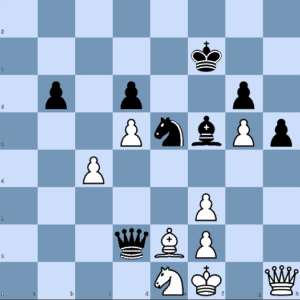
White has no moves, if 42.Qg1 Bh3+ 43.Ng2 Qc1+ or 42.Qg2 Qc1 43.f4 Nd3.
Test Your Strength
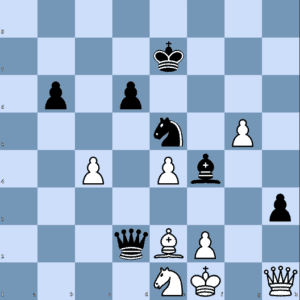
Black to play and win
Highlight the space below this line to reveal the answer.
42…Qc3 43.g6 Bd2 wins the knight.
The Young Duda
JAN-KRZYSZTOF Duda won the FIDE World Cup, defeating Sergey Karjakin in just 30 moves in the second game of the match. In game one, Karjakin confused his opening preparation and felt compelled to head for an early repetition of moves. In the return, Karjakin fell into a line Duda had prepared. The resulting position was defensible, but Karjakin’s renowned abilities in such situations deserted him.
Duda was a deserved winner, eliminating Alexander Grischuk, Santosh Vidit and Magnus Carlsen in successive rounds. The 23-year-old Pole took home $110,000 (£79,000).
J. K. Duda – S Karjakin
Queen’s Gambit Semi Tarrasch
1.d4 Nf6 2.c4 e6 3.Nf3 d5 4.Nc3 c5 5.cxd5 cxd4 6.Qxd4 exd5 7.Bg5 Be7 8.e3 0–0 9.Rd1 Nc6 10.Qa4 Be6 11.Bb5 Qb6 12.Bxf6 Bxf6 13.Nxd5 Bxd5 14.Rxd5 Bxb2 15.Ke2!? (15.0–0 was fine, but Duda is already reckoning on an endgame) 15…Bf6 16.Rhd1 Rac8 17.Bc4 Qb4?! (17…a6 was better although Black suffers after 18.Qb3 Qxb3 19.Bxb3 b5 20.Rd7) 18.Qb3! Qxb3 19.Bxb3 Nb8? (If 19…Rc7? 20.Rd7 Rfc8 21.Bxf7+ and after 19…a6 20.Rd7 b5 21.g4 is like the game) 20.g4! h6? (20…g6 was better, if 20…Rcd8 21.g5 Be7 22.Ne5 Rxd5 23.Bxd5 wins a pawn, if 23…Bxg5 24.Nxf7!) 21.h4 g6 22.g5 hxg5 23.hxg5 Be7 (If 23…Bg7 24.Nh4 Rc6 25.f4 followed by f4–f5 is crushing) 24.Re5 Nc6 (After 24…Bd8 White can switch with 25.Rh1 Kg7 26.Re4 Rh8 27.Rxh8 Kxh8 28.Re8+ or here 26…Rc5 27.Reh4 Bxg5 28.Rh7+ Kf6 29.Nd4! and f2–f4 will trap the bishop, if 29…Ke7 30.Ne6)
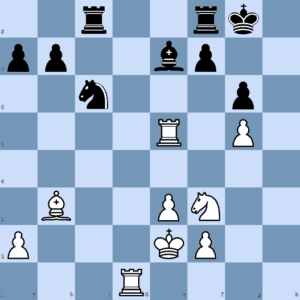
25.Rd7!! Bd8 (If 25…Nxe5 26.Nxe5 is too strong, Rxe7, Rxb7 and Nxg6 are threatened and if 26…Bxg5 27.Nxf7 Rxf7 28.Rxf7 Kh8 29.Rxb7 when Black must lose another pawn or submit to 29…Ra8 30.f4 Bf6 31.Kf3) 26.Rb5 Na5? (Even after the better 26…b6 27.Ne5 Nxe5 28.Rxe5 a5 29.Red5 Bc7 30.f4 Kg7 31.Kf3 Black has no useful moves)
Test Your Strength
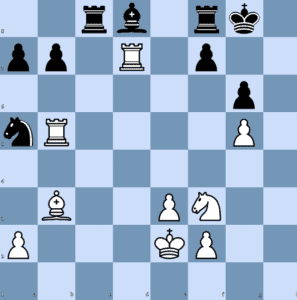
For today’s puzzle, how could Duda have won material immediately?
27.Bd5 Rc7 28.Bxf7+ Kg7 29.Rxc7 Bxc7 30.Bd5 1–0 If 30…a6 31.Rb1 b5 32.Nd4 or if Black defends b7 with 30…Bb6 White targets g6 and after 31.Be4 Nc6 32.Bxc6 bxc6 33.Re5 Rb8 34.Re6 Bd8 35.Ne5 wins.
Highlight the space below this line to reveal the answer.
27.Rxd8 and Rxa5.
Like Father Like Son
MARK Heidenfeld won the 100th Irish Chess Championship in Dublin. It was the 53-year-old IM’s second national title, having previously triumphed back in 2000, although that still leaves him four titles shy of his father, the famous Wolfgang Heidenfeld, who won six Irish Championships between 1958 and 1972.
Heidenfeld lost to defending champion FM Tom O’Gorman in round four, but otherwise only dropped half a point against GM Alex Baburin and generally impressed against the younger generation.
Leading scores: 1 Heidenfeld 7.5/9; 2 Murphy 6.5; 3-7 Baburin, O’Gorman, Fitzsimons, O’Donnell, Tarun Kanyamarla 6.
Solid, sensible positional chess was the cornerstone of Heidenfeld’s success, although he also won a couple of miniatures, not least when Sean Murphy transposed into a bad type of Gruenfeld.
M. Heidenfeld – S. Murphy
Gruenfeld Defence (by transposition)
1.d4 Nf6 2.Nf3 c5 3.e3 g6 4.c4 Bg7 5.Nc3 d5? (5…cxd4 6.exd4 d5! is correct) 6.dxc5! Qa5 7.cxd5 Nxd5 (7…0-0 8.Bd2 Qxc5 9.Qb3 followed by Rc1 or e4 is also excellent for White) 8.Qxd5! Bxc3+ 9.Bd2 Bxd2+ 10.Qxd2 Qxc5?? (A Finnish GM once stumbled into this position too and 10…Qxd2+ 11.Nxd2 0-0 12.Rc1 left him a clear pawn down in Yusupov-Nyback, Puhajarve 2019) 11.Rc1 Qf5 12.Nd4! (The black queen finds herself overloaded) 12…Qd7 13.Bb5 Nc6
Test Your Strength
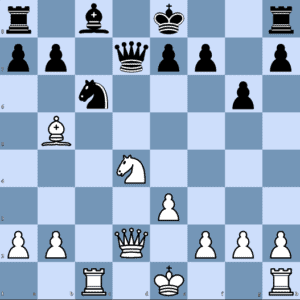
White to play and win
M. Heidenfeld – S. Duffy
Hippopotamus Defence
1.e4 b6 2.d4 Bb7 3.Bd3 e6 4.Qe2 d6 5.f4 Nd7 6.Nf3 g6 7.0-0 Bg7 8.c3 Ne7 9.f5!? e5? (The calm 9…exf5 10.exf5 0-0 was critical) 10.fxg6 hxg6 11.Ng5 (Eyeing that classic weakness, f7. 11.Bc4 is also strong) 11…0-0? (11…Bf6 was grim, but essential)
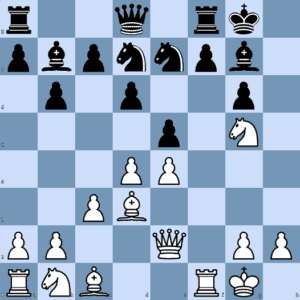
(Now 12.Qg4! (or 12 Qe1! and Qh4) pretty much wins, and if 12…Nf6 13.Qh4 Nh5 14.g4 f6 15.Ne6, or 12…Bf6 and only then 13 Bc4, or just 13.Qh4 Bxg5 14.Bxg5) 12.Bc4 d5 13.Qf3? (13.Qg4!) 13…Bf6? (13…Nf6! is unclear in view of 14.Qh3? Qd7) 14.exd5 exd4? (14…Nf5 15.Qg4 Nd6 was essential) 15.Qh3! Bxg5 16.Bxg5 Bc8 17.Qh4 dxc3 18.Nxc3 Re8 19.d6! Ne5 20.Bf6 1-0
Highlight the space below this line to reveal the answer.
14.Rxc6! Kf8 15.Rxg6 Qd5 16.Rg3 e5 17.Qb4+ 1-0 14.Qc3 also wins.
Raoof Returns
THE MUSWELL Hill International concludes today in London. The event is organised by Adam Raoof, who has staged over 300 Golders Green Quickplay tournaments since 1990. Raoof ’s 10-player IM-norm tournament is supported by Ben Software Ltd and the Friends of Chess charity. He hopes to run them every other month.
The Chessable Masters online at Chess24 was the eighth tournament in the $1.6m (£1.15m) Meltwater Champions Chess Tour. Magnus Carlsen was otherwise engaged at the FIDE World Cup. Pentala Harikrishna was a high-profile casualty in the preliminaries despite making a comeback here.
A. Firouzja – P. Harikrishna
Caro Kann Short Variation
1.e4 (The players reach a position akin to the Advance Variation of the French Defence, but with Black’s light bishop outside the pawn chain) 1…c6 2.d4 d5 3.e5 Bf5 4.Nf3 e6 5.Be2 c5 6.c3 Nc6 7.0–0 cxd4 8.cxd4 (8.Nxd4 Nge7 9.Nxf5 Nxf5 10.Bd3 looked a little better for White in Carlsen-Harikrishna, Lichess.org, 2020) 8…Bg4 9.Nbd2 Nge7 10.h3 Bh5 11.a3 Qb6 12.b4!? Nxd4! 13.Nxd4 Qxd4 14.Qa4+ (14.Bxh5 Qxa1) 14…Nc6 15.Nb3 Qxe5 16.Bxh5 (Or 16.Ba6!? Qc7 17.Bf4! Qxf4 18.Bxb7 Bd6 19.Qxc6+ Ke7 20.g3 Qg5 21.Bxa8 Bxg3 draws) 16…Bd6! (16…Qxh5 17.Na5 Rc8 18.Nxc6 Rxc6 19.Qxa7 wins back both pawns and keeps the initiative) 17.f4 Qxh5 18.Na5
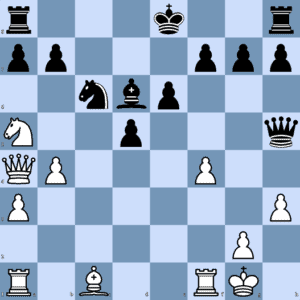
18…Ke7? (I assume that Black overlooked the idea below, but this should have lost by force. 18…0–0!! 19.Nxb7 looks disastrous for Black, but after 19…Be7 20.Qxc6 Qe2! 21.Rf2 Qe1+ 22.Rf1 Qe2, White has no better than a repetition of moves and if 21.Rb1 Rfc8 22.Qa4 Rc2 or 21.Nc5 Bf6 22.Rb1 Bd4+ wins) 19.Nxb7 Rhc8 20.b5 Nd8 21.Nxd6 Kxd6 22.Qb4+ (22.f5! e5 23.Bd2 gives White a decisive attack; after 22.Bd2 Qe2 23.Bb4+ Kd7 24.b6+ Rc6 the computer claims that miraculously, Black is still on the board) 22…Kd7 23.a4 Qh4 24.Ba3 Nb7 25.Rad1 Rc2 26.Qb3? (Giving Black a tempo to get organised and missing 26.b6! Qg3 27.Qe7+ Kc8 28.Qe8+ Nd8 29.b7+ Kxb7 30.Qd7+ Rc7 31.Rb1+ Ka6 32.Qb5#) 26…Rac8 27.Bb4 R8c4 28.f5
Test Your Strength
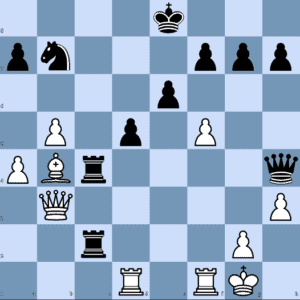
Black to play and win
28…Qg5! 29.fxe6+ fxe6 30.Rf7+ Kc8 31.Rf8+ Nd8! 32.g3 (32.Rf2 Rxf2 33.Kxf2 Qf4+ picks up the bishop) 32…R4c3! 33.Rxd8+ (33.Bxc3 Qe3+ 34.Kh1 Qe4+ 35.Kg1 Qg2#) 33…Kxd8 34.Ba5+ Ke8 0–1
Baptism of Fire
THE WORLD’S youngest GM, Abhimanyu Mishra, had a baptism of fire when he was handed a wild card place in the Chessable Masters, online at Chess24. The 12-year-old from New Jersey scored only 2.5/15 in the preliminary rounds, but did have the pleasure of defeating his coach Pentala Harikrishna.
The youngster matched many of the greats for much of the game and, in doing so, drew some high praise from Magnus Carlsen, who was dipping into the commentary from time to time. Mishra was in a dead-level double rook endgame against Wesley So but was eventually ground down. So ended at the head of the preliminaries.
The qualifiers were Wesley So, Hikaru Nakamura, Vladislav Artemiev, Alireza Firouzja, Levon Aronian, Le Quang Liem, Shak Mamedyarov, Jorden van Foreest.
S. Mamedyarov – A. Mishra
Sicilian c3
Chessable Masters Prelim Chess24.com
1.e4 c5 2.c3 Nf6 3.e5 Nd5 4.Bc4 Nb6 5.Bb3 d6 6.exd6 Qxd6 7.Nf3 c4 (Black takes the opportunity to disrupt White’s development. On the flip side, the black queen may have to go back to base later) 8.Bc2 Qe6+ 9.Kf1 g6 (9…Nc6 10.a4 Qd5 is the most ambitious plan) 10.b3 (The standard way to activate the white position, 10.d4 cxd3 11.Qxd3 Bg7 is comfortable for Black) 10…Bg7 11.Na3 cxb3 12.axb3 0–0 13.d4 Nc6 14.h4 (One would expect nothing less from Shak) 14…h5 15.Bg5 Qd7 (Black needs to get his queen out of the way of his queen’s bishop. Not 15…Qg4 16.Qd2 Bf5 17.Nh2. However, 15…Qd5!? was interesting and if 16.c4 Qd8 17.d5 Nb4 18.Be4 Nd7! intending Nd7–f6 or c5 and a7–a5) 16.Qe1 e6 17.Rd1 (Now a7–a6 makes sense to limit White’s knight) 17…Nd5 18.c4 Ndb4 19.Be4 (Threat d4–d5 winning a knight) 19…a5 20.Nb5 b6?! 21.Ne5 Qb7 (White has built up a big advantage in mobility but the rook on h1 is suffering from FOMO, Shak helps it out)
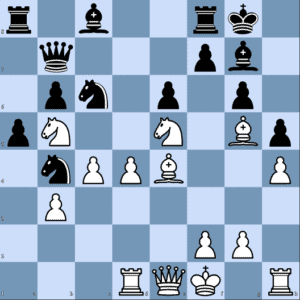
22.g4! hxg4 (22…f6 23.Nxc6 Nxc6 24.Bf4 f5 25.gxf5 exf5 26.Bf3) 23.h5 f5 24.Bg2 (White can win any way he chooses. 24.Nxg6 fxe4 25.h6 Bh8 26.h7+ Kg7 27.Nxf8 Kxf8 28.Nd6 Qd7 29.Qxe4 Qxd6 30.Qg6) 24…Bxe5 25.dxe5 Qh7 26.Qd2 gxh5 27.Bh6 Rf7
Test Your Strength
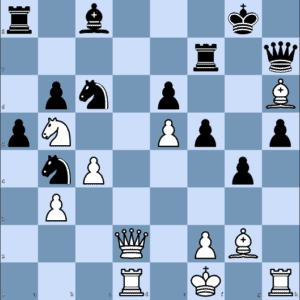
White to play and mate in three moves
Highlight the space below this line to reveal the answer.
28.Qd8+ Nxd8 29.Rxd8+ Rf8 30.Rxf8# 1–0
Tune in next week for more of Malcolm Pein’s instructive Daily Telegraph columns.


